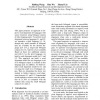Free Online Productivity Tools
i2Speak
i2Symbol
i2OCR
iTex2Img
iWeb2Print
iWeb2Shot
i2Type
iPdf2Split
iPdf2Merge
i2Bopomofo
i2Arabic
i2Style
i2Image
i2PDF
iLatex2Rtf
Sci2ools
ACL
2006
2006
Word Alignment for Languages with Scarce Resources Using Bilingual Corpora of Other Language Pairs
This paper proposes an approach to improve word alignment for languages with scarce resources using bilingual corpora of other language pairs. To perform word alignment between languages L1 and L2, we introduce a third language L3. Although only small amounts of bilingual data are available for the desired language pair L1-L2, large-scale bilingual corpora in L1-L3 and L2-L3 are available. Based on these two additional corpora and with L3 as the pivot language, we build a word alignment model for L1 and L2. This approach can build a word alignment model for two languages even if no bilingual corpus is available in this language pair. In addition, we build another word alignment model for L1 and L2 using the small L1-L2 bilingual corpus. Then we interpolate the above two models to further improve word alignment between L1 and L2. Experimental results indicate a relative error rate reduc
| Added | 30 Oct 2010 |
| Updated | 30 Oct 2010 |
| Type | Conference |
| Year | 2006 |
| Where | ACL |
| Authors | Haifeng Wang, Hua Wu, Zhan-yi Liu |
Comments (0)

